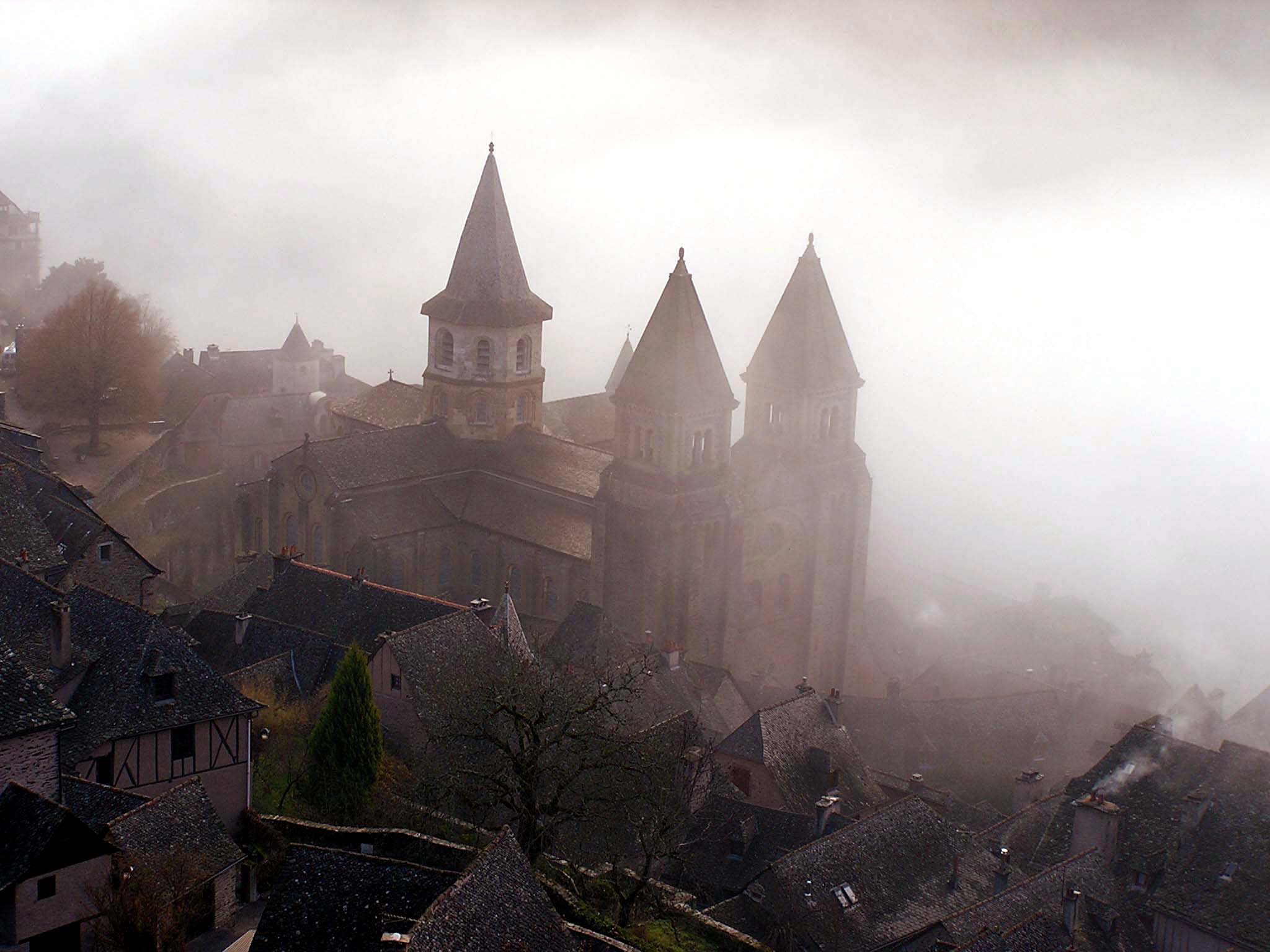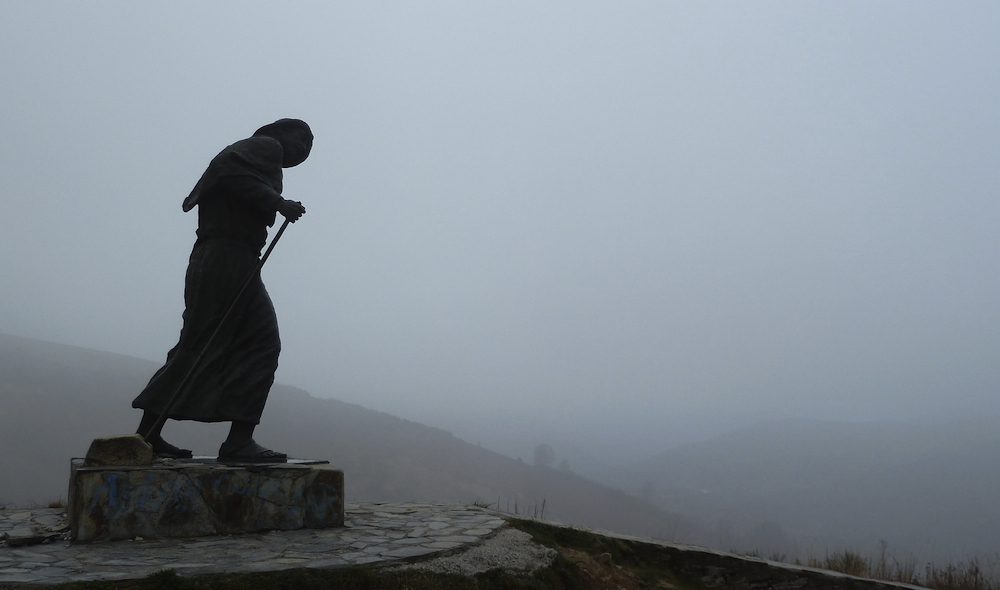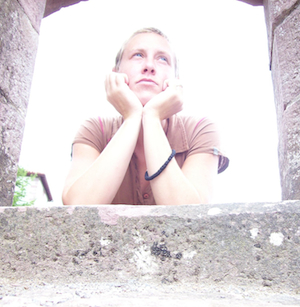Essay by Elisabeth Hedrick-Moser
Finalist for the 2017 Talking Writing Prize for Personal Essay

In 2013, the year Madeleine was born, I had a recurring dream. I'd be shouldering my pack, feeling its familiar weight, stepping into a mountain breeze, and someone would ask, “Where’s Madeleine?” I'd realize in a panic—I forgot her! And the trail would dissipate into my reality of diapers, sour-milk T-shirts, and stumbling in the dark toward the sound of crying. I'd wake up melancholy, brimming with memories of walking the Camino de Santiago, the ancient pilgrimage across France and Spain.
The path is auburn dust and mud, lined with red poppies and grasses swaying in the French breeze. The path folds into thick woods, shafts of rain pelting through pines, nylon, and leather. The path rises at the edge of a gorge; trees break into a panoramic of red-brown stone walls enclosing a village on a precipice. Cathedral spires rise above the ramparts. After nine days of walking, mostly in the rain, I slip over cobbles toward the center of Conques—an abbey tucked in the wild country.
Conques, in south-central France, is a long way from Santiago de Compostela in the northwest corner of Spain, but on this 2011 trip, I didn’t go that far. I was about a third of the way through my month-long trek to San Jean Pied de Port, the beginning of the path that crosses Spain. But four years before, I’d walked the 500-mile stretch from San Jean Pied de Port to Santiago, before I’d even met my husband, before I had any idea I’d be carrying babies instead of a pack.
Inside the abbey, a woman gestures for me to remove my soaked boots, jacket, and pack. I add them to the queue of other wet pilgrims’ accessories. The damp seems to live in my veins. I sit on a wooden bench, and an elderly woman brings me a cup of chamomile tea. I’m given a bunk bed, my sleeping bag unrolled on a plastic mattress. Then I enter a hall of dry pilgrims, eat bread and butter and roasted chicken. Monks smile, passing wine.
Pilgriming exposes the self as a body and a spirit in need, and through that need, teaches the self to receive. To be a pilgrim is to move through the body in contact with the earth in search of the absolute. The wandering self, exposed and vulnerable, is open to encounter.
• • •
I was a reluctant mother, wanting kids eventually, but not yet, when I bought a pregnancy test and a bottle of Evan Williams. I was hoping to forget about this scare over a hefty pour of whiskey in about ten minutes. But the scare turned into a baby, and the bottle waited nine months to give any relief.
I'd been working for eight years toward a doctorate, as was my husband, and the idea of fitting a child into that mix felt daunting. In retrospect, I’ve also realized it was more than daunting as a logistical challenge. At the time, I held a latent belief that motherhood would be a return to oppressions I’d been liberated from.
A student of feminist theory, I had internalized Simone de Beauvoir’s lament in The Second Sex: “There is one feminine function that is actually almost impossible to perform in complete liberty. It is maternity.... [H]aving a child is enough to paralyze a woman’s activity entirely.” De Beauvoir evoked the conundrum women faced in mid-twentieth-century France—and which women still face today—where the advent of a child hinders a career.
I became a Catholic just a year ago, a conversion that really started with my first steps onto the Camino. But I was raised as a conservative Protestant Christian and had always had a fraught relationship with the church—especially with the church’s limited definition of women’s roles. Confinement to the domestic sphere was the last thing I wanted. Any faith that would hold me inside the walls of a domestic identity, I wanted to walk away from. I wanted to roam the earth.
So, it came as a shock to me when I was confined to my home during the coldest winter in Saint Louis in memory, with a newborn on my chest, deep fulfillment expanding in my body as if I were breathing in sky. The ecstasies of those heady days were undeniably mixed, often dominated by adrenaline-rushed responses to my baby’s screams, wells of sobbing, sleepless nights, and power struggles with my husband. But somehow, the fresh air of connection that motherhood let in now shapes my memories of that year.
I was caught off guard when it was time to return to work after six weeks. Go to work? What could I be doing that would be more important than nurturing this life, emerging by the second before my eyes, teaching me what life is, offering up to me the mysteries of my ancestors—joy, life, love, milk—oh God, milk. I felt a marvelous connection to the world of mammals, to the desperate struggle to keep young alive, as if I were hearing my life narrated by David Attenborough.
The great animal drama of nurture unfolded in my home as I rose in the darkness, pulled by electric instincts to my daughter’s cry. Go to work? The job that I felt so strongly about just over a month before seemed like a remote island. I went; I even enjoyed the time away, felt refreshed by turning my mind to teaching. But my work of nurturing called to me with a more distinct tone than any I had experienced.
I struggled as a feminist to reclaim the idea that motherhood could be a vocation, even as I was stunned to feel—deep in my bones, breasts, eyes, ears; in the taste of the winter air—a firm connection with the earth. The work of mothering answered in me a question I had not even asked. It opened windows that let in an air full of mountain tundra that I never knew were there to open.
Every walk I took with my daughter, the world opened before me as if newly created. The sound of leaves crackling under an icy layer of snow. The moon rising over sculpted, gray trees in rose-orange light. See, Madeleine! How could I possibly explain to her what the world is? I searched my mind for words that receded like dew. Time slowed, and my feet felt the chiseling of a gravel pilgrim path.
Go to work? I had been taught in a thousand wordless lessons that being “just a mom” was an unambitious road that avoided the real work of the world. Continuing with my career post-baby, it seemed to me, was not even a choice; it was a necessity. Clearly, I would carry on with the career path I had been treading to its natural end—the decade of graduate school would lead to a full-time position, and the child-rearing would happen in the early morning and the evening and snippets of weekends.
I accepted a one-year position at a university teaching center, negotiated a thirty-hour work week—an excellent compromise. But then the funding situation changed, and the position was withdrawn. After weeks of grieving the loss (it had been a dream job), I started to see another path before me with branches I hadn't yet explored. My spouse had a teaching job that could support the three of us, if we kept living lean. I could focus on writing. And I felt a strong draw to be more fully present in my daughter’s life, for her to be more present in my life.
• • •
It took me a couple years of motherhood to realize that the paradigm of career and economic advancement as markers of success was not helpful to me. That path didn’t lead me where I wanted to be. I wanted to live fully and deeply on the earth; to be whole in my body, mind, and spirit; to be open to encountering the absolute. I wanted to live the life of a pilgrim. And when I mapped the pilgrim path onto my experiences as a mother, I recalibrated my sense of the value of mothering.
This recalibration didn’t solve any of my quandaries about navigating the career-oriented world—or how the culture might better value the work of nurture—but it gave me a balance with which I could walk forward.
On pilgrimage, your sense of what Thomas Merton calls the false self, the shell of identity we clothe ourselves in to appear to others and ourselves as worthy of attention, is eroded by the rocky path, until you experience yourself as a body among other bodies in pain. Childbirth, for me, was an experience so physical that it became spiritual. The need to endure the opening of my own body in order to push another human into life flung me into a reality that is rarely made tangible—the primal need we have for each other; the ability to breathe with another so that your breath slows and mirrors their calm.
Mothering, like pilgriming, teaches you to seek the absolute in the midst of the mundane, in the repetitive; it’s training in mindfulness and mindlessness. The meseta on the Spanish part of the Camino de Santiago stretches for over a week of full, eight-hour days of walking straight ahead, in full sun, through fields of wheat to the receding horizon curving against sharp blue. Pushing a child on a swing, surrounded by small talk and screaming toddlers, stepping endlessly over toys across carpet, returning again to a sink full of dishes—or walking in the relentless heat in unending dirt and wheat—reveals the mind, alone and bitter. Where does the mind go when it faces the empty expanse?
Mothering, like pilgriming, has taught me to honor the space I pass through and to be aware of those who have walked before me. The pilgrim path to Santiago was carved by the feet of a millennia of pilgrims, walking westward toward the bones of Saint James, seeking healing, seeking the reason for their trek on Earth. As they walk, they come across cairns, crooked piles of rocks stacked at crossroads. They stoop beneath the weight of their belongings—the weight of their material needs—pick up a rock, and balance it on top of the weight of those who have come before.
Now, I hold my second daughter, sixteen-month-old Catherine, in the crook of my arm. She’s milk-drunk and asleep, serene. I trace the contours of her brows, her nose, her cheeks, and in the pattern, I feel my own mother’s finger gliding over my skin. Repeating her work, stepping in the path of her feet, her grace, her anger and endurance, gives me strength and rootedness. I walk in the path her feet have walked. I place a small rock in a growing, tilting pile.

Publishing Information
- The Second Sex by Simone de Beauvoir (Editions Gallimard, 1949).
- New Seeds of Contemplation by Thomas Merton (New Directions, 1961).
Art Information
- "Conques" © stephrox; Creative Commons license.
- "Camino de Santiago April 3, 2012" © Fresco Tours; Creative Commons license.
 A native of El Paso, Texas, Elisabeth Hedrick-Moser lives in San Antonio, where she explores the city and the surrounding hill country with her two daughters and husband. She earned a doctorate in English Literature from Saint Louis University and has published academic essays on war literature, trauma, and teaching. Currently, Elisabeth is writing a series of essays meditating on experiences of motherhood through the paradigm of pilgrimage. One of these, “Speed and Space of Mind,” was recently published in Lucia Journal.
A native of El Paso, Texas, Elisabeth Hedrick-Moser lives in San Antonio, where she explores the city and the surrounding hill country with her two daughters and husband. She earned a doctorate in English Literature from Saint Louis University and has published academic essays on war literature, trauma, and teaching. Currently, Elisabeth is writing a series of essays meditating on experiences of motherhood through the paradigm of pilgrimage. One of these, “Speed and Space of Mind,” was recently published in Lucia Journal.
You can follow Elisabeth on Twitter @ehedrickmoser.
